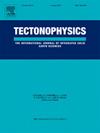Crustal geoelectric structure of the Indian plate at the western extremity of the Bundelkhand craton and Sharda Depression in the Ganga Basin
IF 2.7
3区 地球科学
Q2 GEOCHEMISTRY & GEOPHYSICS
引用次数: 0
Abstract
The latest episode in the geodynamic evolution of the Ganga Basin invokes continent-continent collision, Himalayan mountain building, and flexure of the Indian plate, which resulted in deposition of thick alluvial sediments in the basin masking the geological heterogeneities of the Indian plate. In recent years, a series of magnetotelluric (MT) studies in the central Ganga Basin have brought out information about its basement and crustal structure. In the present study, we have covered the region between Gwalior and Tanakpur falling at the western extremity of the Bundelkhand craton (BKC) in south and the super-deep Sharda Depression in north (at the Himalayan foothills) by a 330 km long profile to delineate the crustal structure of the region. The geoelectric model of the crustal structure derived from 2-D inversion of broadband MT data reveals the presence of the BKC underneath the alluvial sediments as a resistive northward dipping block in this region also, implying that the BKC extends northward of its presently known boundary shown in the geological map of the region. This cratonic block is buried beneath about 5 km thick moderately resistive rocks of the Vindhyan Supergroup. The results also reveal the presence of an upper-thick Proterozoic rift basin with its deepest part more than 30 km thick within the Sharda Depression, and two lithospheric mantle conductors in the central sector of the profile indicating the possibility of the presence of a significant conductive anomaly at deep lithospheric level. The top conducting layer in the model consisting of the Shiwaliks and Recent alluvium deposited in the flexural environment gradually thickens northward and attains a thickness of about 5 km at the foothills. The results reveal that the crustal structure of this part of the Ganga Basin is highly heterogeneous across the basin.
印度板块本德尔坎德克拉通西端和恒河盆地沙尔达坳陷的地壳电性结构
恒河盆地地球动力学演化的最新阶段涉及大陆与大陆的碰撞、喜马拉雅山脉的形成和印度板块的弯曲,这些导致了盆地内厚冲积沉积物的沉积,掩盖了印度板块的地质非均质性。近年来,在恒河盆地中部进行了一系列大地电磁研究,揭示了恒河盆地基底和地壳结构。在本研究中,我们用一条330公里长的剖面覆盖了南部位于本德尔坎德克拉通(BKC)西端的瓜里奥尔和塔纳克布尔之间的区域,以及北部位于喜马拉雅山麓的超深沙达坳陷(Sharda Depression),以描绘该地区的地壳结构。利用宽带MT数据二维反演得到的地壳结构地电模型显示,BKC在冲积沉积层下以阻性北倾块体的形式存在,表明BKC在该地区地质图中已知的边界向北延伸。这个克拉通块体被埋在约5公里厚的温德哈扬超群的中等阻性岩石下。结果还表明,在沙达坳陷内存在上厚元古代裂谷盆地,其最深部分厚度超过30 km,剖面中央部分有两条岩石圈地幔导体,表明岩石圈深部可能存在明显的导电异常。模型的顶部导电层由Shiwaliks和最近沉积在弯曲环境中的冲积层组成,逐渐向北增厚,在山麓处达到约5 km的厚度。结果表明,恒河盆地这部分地壳结构在整个盆地内具有高度的非均质性。
本文章由计算机程序翻译,如有差异,请以英文原文为准。
求助全文
约1分钟内获得全文
求助全文
来源期刊

Tectonophysics
地学-地球化学与地球物理
CiteScore
4.90
自引率
6.90%
发文量
300
审稿时长
6 months
期刊介绍:
The prime focus of Tectonophysics will be high-impact original research and reviews in the fields of kinematics, structure, composition, and dynamics of the solid arth at all scales. Tectonophysics particularly encourages submission of papers based on the integration of a multitude of geophysical, geological, geochemical, geodynamic, and geotectonic methods
 求助内容:
求助内容: 应助结果提醒方式:
应助结果提醒方式:


